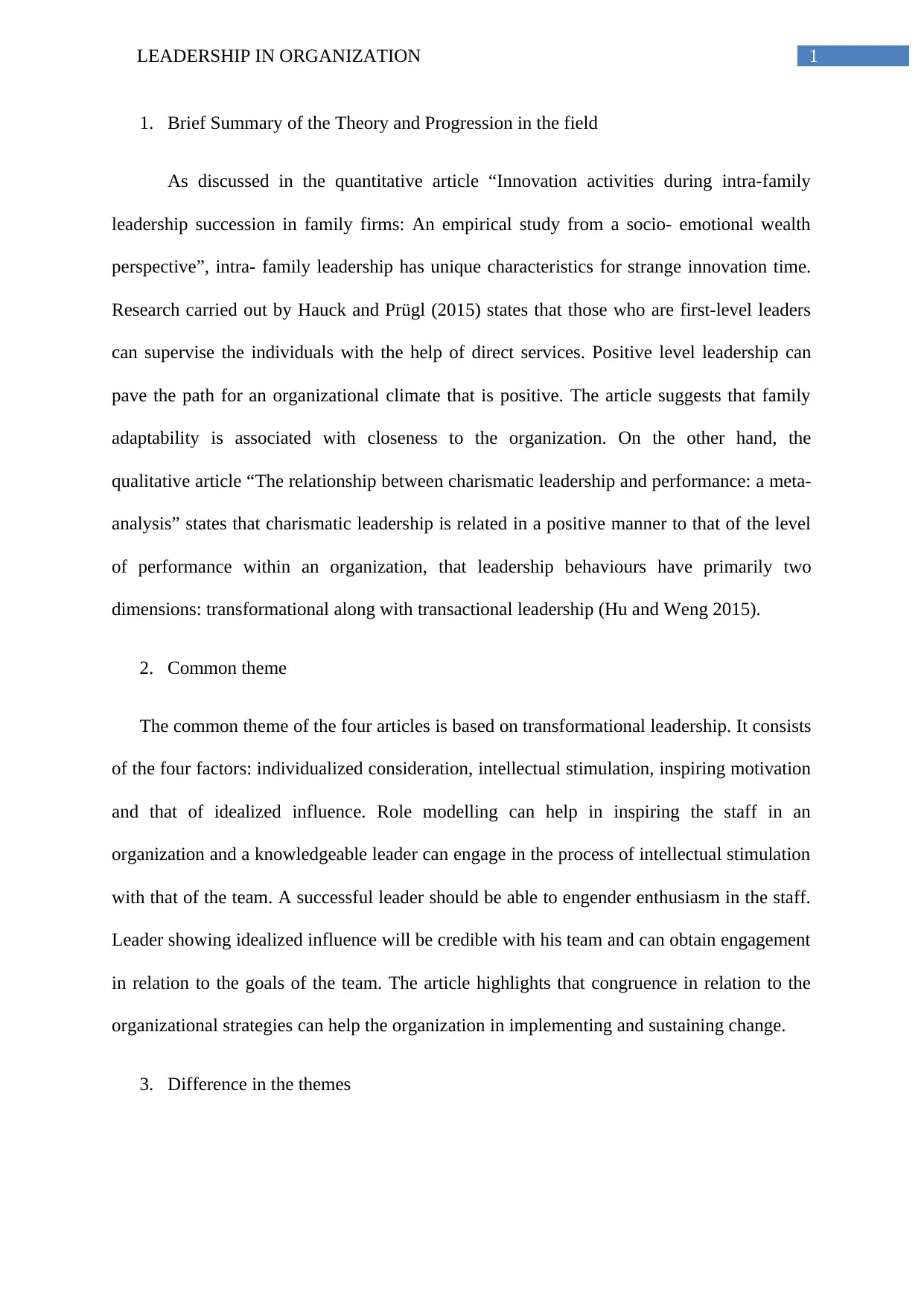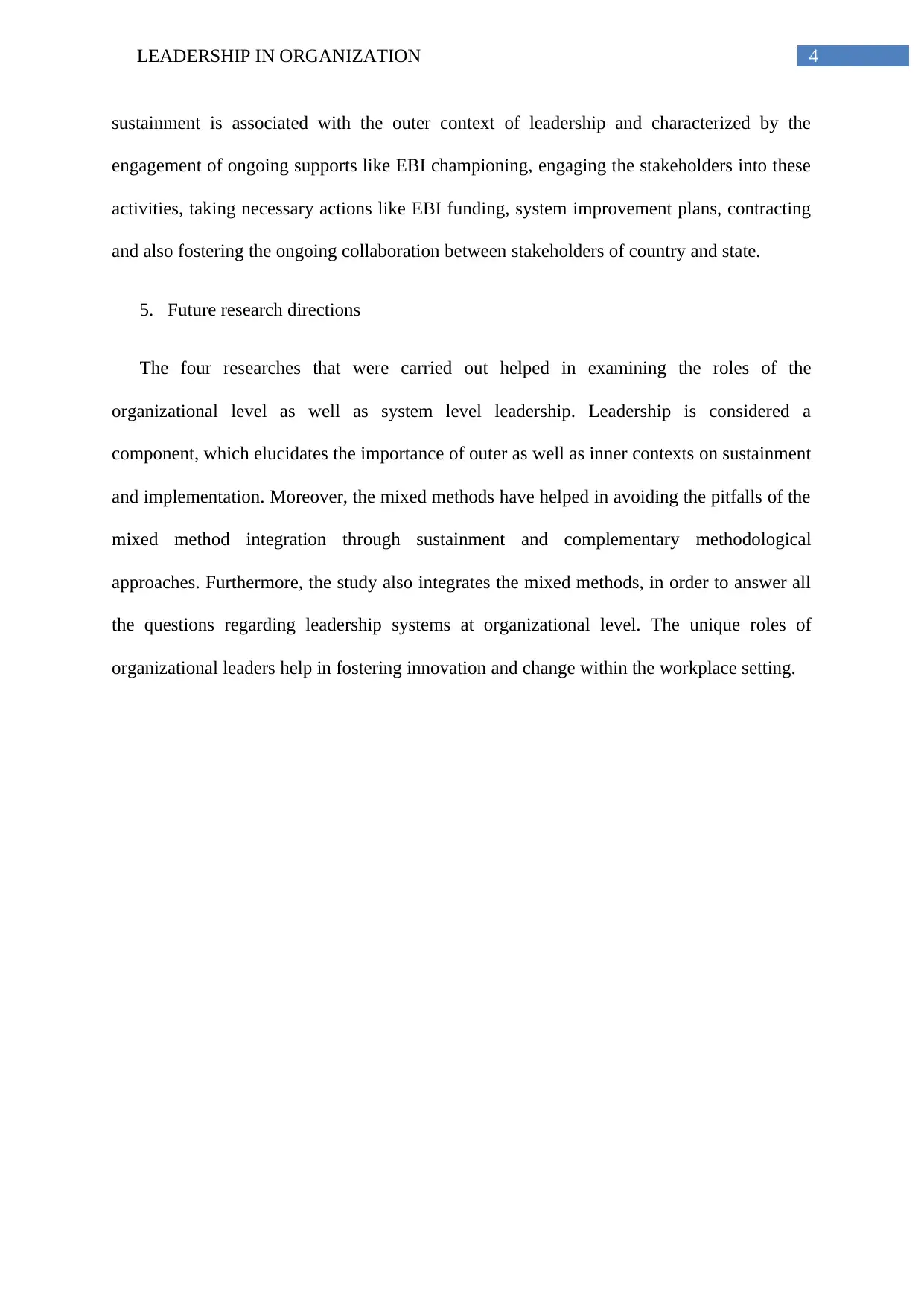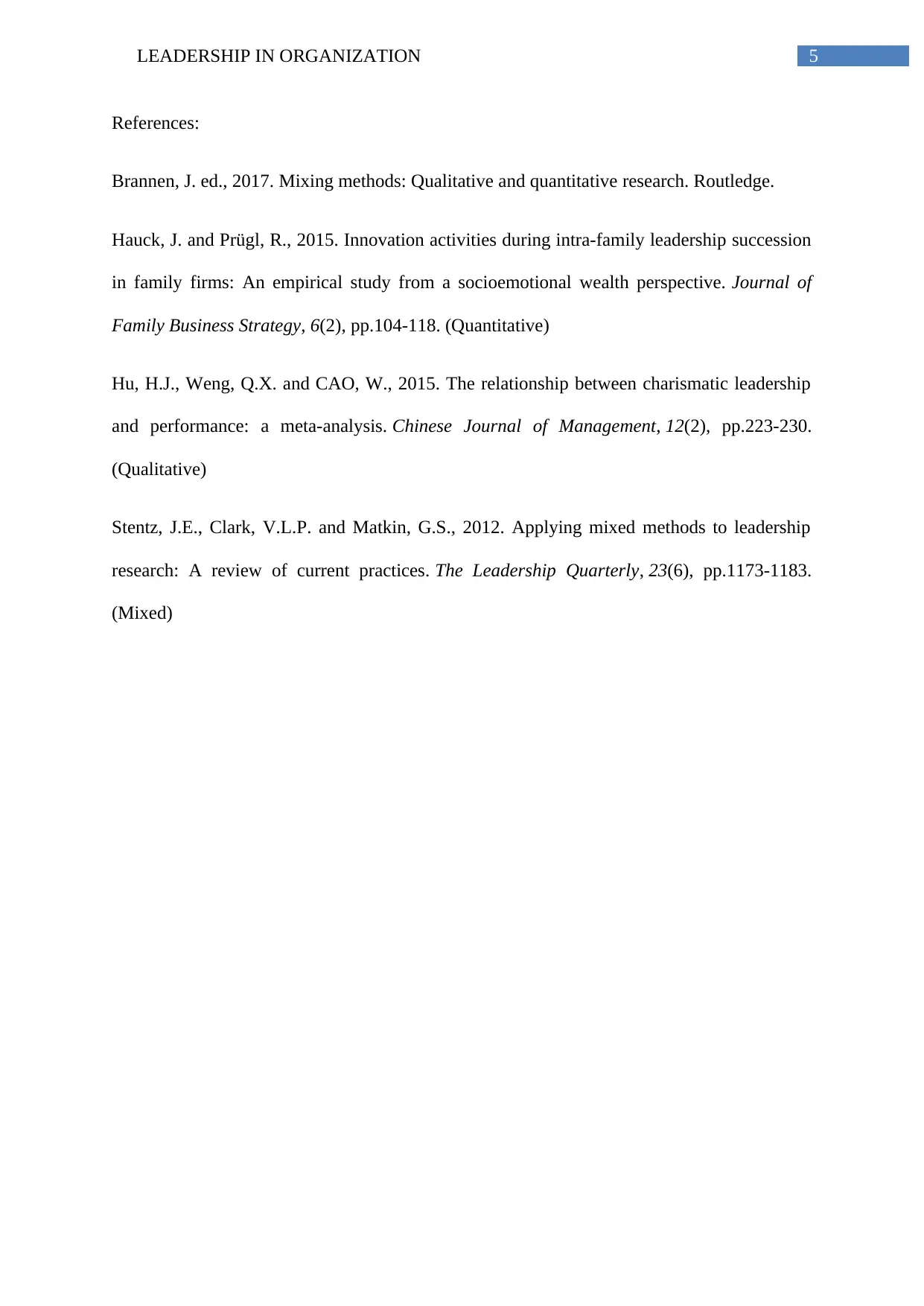Leadership in Organization: Research and Comparative Analysis Report
VerifiedAdded on 2021/04/21
|6
|1307
|25
Report
AI Summary
This report analyzes various aspects of leadership within organizations, drawing from both quantitative and qualitative research. It explores transformational leadership, highlighting its four key factors: individualized consideration, intellectual stimulation, inspiring motivation, and idealized influence. The report compares and contrasts charismatic leadership with intra-family leadership, examining their impact on performance and innovation. It also discusses succession planning and management components, emphasizing the importance of leadership at both organizational and system levels. Study limitations and differences in research designs are addressed, alongside future research directions. The report references multiple studies, including those by Hauck and Prügl (2015), Hu and Weng (2015), and Stentz, Clark, and Matkin (2012), providing a comprehensive overview of leadership theories and practices within organizational contexts. The importance of leadership in fostering innovation, change, and a healthy work environment is also discussed.

Running head: LEADERSHIP IN ORGANIZATION
Leadership in Organization
Name of the student
Name of the University
Author note
Leadership in Organization
Name of the student
Name of the University
Author note
Paraphrase This Document
Need a fresh take? Get an instant paraphrase of this document with our AI Paraphraser

1LEADERSHIP IN ORGANIZATION
1. Brief Summary of the Theory and Progression in the field
As discussed in the quantitative article “Innovation activities during intra-family
leadership succession in family firms: An empirical study from a socio- emotional wealth
perspective”, intra- family leadership has unique characteristics for strange innovation time.
Research carried out by Hauck and Prügl (2015) states that those who are first-level leaders
can supervise the individuals with the help of direct services. Positive level leadership can
pave the path for an organizational climate that is positive. The article suggests that family
adaptability is associated with closeness to the organization. On the other hand, the
qualitative article “The relationship between charismatic leadership and performance: a meta-
analysis” states that charismatic leadership is related in a positive manner to that of the level
of performance within an organization, that leadership behaviours have primarily two
dimensions: transformational along with transactional leadership (Hu and Weng 2015).
2. Common theme
The common theme of the four articles is based on transformational leadership. It consists
of the four factors: individualized consideration, intellectual stimulation, inspiring motivation
and that of idealized influence. Role modelling can help in inspiring the staff in an
organization and a knowledgeable leader can engage in the process of intellectual stimulation
with that of the team. A successful leader should be able to engender enthusiasm in the staff.
Leader showing idealized influence will be credible with his team and can obtain engagement
in relation to the goals of the team. The article highlights that congruence in relation to the
organizational strategies can help the organization in implementing and sustaining change.
3. Difference in the themes
1. Brief Summary of the Theory and Progression in the field
As discussed in the quantitative article “Innovation activities during intra-family
leadership succession in family firms: An empirical study from a socio- emotional wealth
perspective”, intra- family leadership has unique characteristics for strange innovation time.
Research carried out by Hauck and Prügl (2015) states that those who are first-level leaders
can supervise the individuals with the help of direct services. Positive level leadership can
pave the path for an organizational climate that is positive. The article suggests that family
adaptability is associated with closeness to the organization. On the other hand, the
qualitative article “The relationship between charismatic leadership and performance: a meta-
analysis” states that charismatic leadership is related in a positive manner to that of the level
of performance within an organization, that leadership behaviours have primarily two
dimensions: transformational along with transactional leadership (Hu and Weng 2015).
2. Common theme
The common theme of the four articles is based on transformational leadership. It consists
of the four factors: individualized consideration, intellectual stimulation, inspiring motivation
and that of idealized influence. Role modelling can help in inspiring the staff in an
organization and a knowledgeable leader can engage in the process of intellectual stimulation
with that of the team. A successful leader should be able to engender enthusiasm in the staff.
Leader showing idealized influence will be credible with his team and can obtain engagement
in relation to the goals of the team. The article highlights that congruence in relation to the
organizational strategies can help the organization in implementing and sustaining change.
3. Difference in the themes

2LEADERSHIP IN ORGANIZATION
On one hand, the qualitative article has focused on the charismatic leadership whereas the
quantitative article has focused on intra- family relationship. There were three research
questions designed for this study- Are the four succession planning and management
components related structurally? Is there a difference in the evaluation of succession planning
and management components done by the senior and middle level managers? Is there a
difference in size and location of the institutions relative to the standard of succession
planning and management components? The theme of succession planning and management
components were well- described in this article, however there was a lack of an appropriate
instrument for the same. In order to recover this gap in the research, a new instrument was
developed named as Wright Coward Succession Planning and Management Survey or
WCSPMS. To evaluate the collected data, an exploratory factor analysis was carried out to
answer the specific research questions. It also helped in evaluating the structural relationship
of the succession planning and the management components in general. There was another
second statistical procedure along with multivariate analysis of variance for measuring the
differences between the four dependent components of succession planning and the
leadership and management level. The findings of this quantitative study has focused on
items of the newly developed instrument are related to three components of successful
planning and managerial factors. In addition to that, there is also a statistical difference
between the levels of leadership and the management practices. It can be summarized from
the article that a lot more can be done by the community leaders in the specific field.
The article states that charismatic leadership can inspire the workers within an
organization so that they can achieve the organizational goals. Regional culture can help in
moderating the relationship between that of charismatic leadership and that of the individual
performance. The article written by Bruce and Dail, (2015) on the basis of the ten-item-scale
focussed on aspects like that of transformational leadership behaviour, transactional
On one hand, the qualitative article has focused on the charismatic leadership whereas the
quantitative article has focused on intra- family relationship. There were three research
questions designed for this study- Are the four succession planning and management
components related structurally? Is there a difference in the evaluation of succession planning
and management components done by the senior and middle level managers? Is there a
difference in size and location of the institutions relative to the standard of succession
planning and management components? The theme of succession planning and management
components were well- described in this article, however there was a lack of an appropriate
instrument for the same. In order to recover this gap in the research, a new instrument was
developed named as Wright Coward Succession Planning and Management Survey or
WCSPMS. To evaluate the collected data, an exploratory factor analysis was carried out to
answer the specific research questions. It also helped in evaluating the structural relationship
of the succession planning and the management components in general. There was another
second statistical procedure along with multivariate analysis of variance for measuring the
differences between the four dependent components of succession planning and the
leadership and management level. The findings of this quantitative study has focused on
items of the newly developed instrument are related to three components of successful
planning and managerial factors. In addition to that, there is also a statistical difference
between the levels of leadership and the management practices. It can be summarized from
the article that a lot more can be done by the community leaders in the specific field.
The article states that charismatic leadership can inspire the workers within an
organization so that they can achieve the organizational goals. Regional culture can help in
moderating the relationship between that of charismatic leadership and that of the individual
performance. The article written by Bruce and Dail, (2015) on the basis of the ten-item-scale
focussed on aspects like that of transformational leadership behaviour, transactional
⊘ This is a preview!⊘
Do you want full access?
Subscribe today to unlock all pages.

Trusted by 1+ million students worldwide

3LEADERSHIP IN ORGANIZATION
behaviour and that of servant leadership. This can serve as a useful tool that can help in the
arena of leadership development. A servant leader listens to the opinions and advice of other
people and takes a decision on that basis. A servant leader listens intently to what other
people are saying and reflection on regular basis can help in the development of an
organization. According to this article, a servant leader empathizes with the feelings of other
people for the overall profit of the organization.
4. Study limitations and difference in research designs
There were study limitations while carrying out this tresearch work. A mixed method
study conducted by Stentz, Clark and Matkin (2012) has mentioned regarding the importance
of implementation of the leadership theories for the innovation in businesses. Empirical
evidences have supported the overall importance of leaders into the implementation
procedure. The studies of the organizational teams have however, demonstrated the fact that
effective leadership sets the stage of psychological safety as well as positive team
functioning. The inclusion of organizational leadership helps in facilitating effective
implementation as well as sustainment of the innovative procedures. Moreover, the
transformational leadership is also important in developing a healthy work environment, with
positive attitudes and innovation. The mixed method study conducted by Brannen (2017)
indicated that the employees of any organization have the need for leadership mainly at
situations when there is uncertainty or instability.
According to Stentz, Clark and Matkin (2012), organizational leadership is a key
determinant of sustainment and implementation and the mixed methods he used for this are
preparation, exploration, sustainment and implementation. The quantitative data in the inner
and outer context levels demonstrated the fact that transformational leadership helps in
predicting the future of the organization. The qualitative results suggested that the
behaviour and that of servant leadership. This can serve as a useful tool that can help in the
arena of leadership development. A servant leader listens to the opinions and advice of other
people and takes a decision on that basis. A servant leader listens intently to what other
people are saying and reflection on regular basis can help in the development of an
organization. According to this article, a servant leader empathizes with the feelings of other
people for the overall profit of the organization.
4. Study limitations and difference in research designs
There were study limitations while carrying out this tresearch work. A mixed method
study conducted by Stentz, Clark and Matkin (2012) has mentioned regarding the importance
of implementation of the leadership theories for the innovation in businesses. Empirical
evidences have supported the overall importance of leaders into the implementation
procedure. The studies of the organizational teams have however, demonstrated the fact that
effective leadership sets the stage of psychological safety as well as positive team
functioning. The inclusion of organizational leadership helps in facilitating effective
implementation as well as sustainment of the innovative procedures. Moreover, the
transformational leadership is also important in developing a healthy work environment, with
positive attitudes and innovation. The mixed method study conducted by Brannen (2017)
indicated that the employees of any organization have the need for leadership mainly at
situations when there is uncertainty or instability.
According to Stentz, Clark and Matkin (2012), organizational leadership is a key
determinant of sustainment and implementation and the mixed methods he used for this are
preparation, exploration, sustainment and implementation. The quantitative data in the inner
and outer context levels demonstrated the fact that transformational leadership helps in
predicting the future of the organization. The qualitative results suggested that the
Paraphrase This Document
Need a fresh take? Get an instant paraphrase of this document with our AI Paraphraser

4LEADERSHIP IN ORGANIZATION
sustainment is associated with the outer context of leadership and characterized by the
engagement of ongoing supports like EBI championing, engaging the stakeholders into these
activities, taking necessary actions like EBI funding, system improvement plans, contracting
and also fostering the ongoing collaboration between stakeholders of country and state.
5. Future research directions
The four researches that were carried out helped in examining the roles of the
organizational level as well as system level leadership. Leadership is considered a
component, which elucidates the importance of outer as well as inner contexts on sustainment
and implementation. Moreover, the mixed methods have helped in avoiding the pitfalls of the
mixed method integration through sustainment and complementary methodological
approaches. Furthermore, the study also integrates the mixed methods, in order to answer all
the questions regarding leadership systems at organizational level. The unique roles of
organizational leaders help in fostering innovation and change within the workplace setting.
sustainment is associated with the outer context of leadership and characterized by the
engagement of ongoing supports like EBI championing, engaging the stakeholders into these
activities, taking necessary actions like EBI funding, system improvement plans, contracting
and also fostering the ongoing collaboration between stakeholders of country and state.
5. Future research directions
The four researches that were carried out helped in examining the roles of the
organizational level as well as system level leadership. Leadership is considered a
component, which elucidates the importance of outer as well as inner contexts on sustainment
and implementation. Moreover, the mixed methods have helped in avoiding the pitfalls of the
mixed method integration through sustainment and complementary methodological
approaches. Furthermore, the study also integrates the mixed methods, in order to answer all
the questions regarding leadership systems at organizational level. The unique roles of
organizational leaders help in fostering innovation and change within the workplace setting.

5LEADERSHIP IN ORGANIZATION
References:
Brannen, J. ed., 2017. Mixing methods: Qualitative and quantitative research. Routledge.
Hauck, J. and Prügl, R., 2015. Innovation activities during intra-family leadership succession
in family firms: An empirical study from a socioemotional wealth perspective. Journal of
Family Business Strategy, 6(2), pp.104-118. (Quantitative)
Hu, H.J., Weng, Q.X. and CAO, W., 2015. The relationship between charismatic leadership
and performance: a meta-analysis. Chinese Journal of Management, 12(2), pp.223-230.
(Qualitative)
Stentz, J.E., Clark, V.L.P. and Matkin, G.S., 2012. Applying mixed methods to leadership
research: A review of current practices. The Leadership Quarterly, 23(6), pp.1173-1183.
(Mixed)
References:
Brannen, J. ed., 2017. Mixing methods: Qualitative and quantitative research. Routledge.
Hauck, J. and Prügl, R., 2015. Innovation activities during intra-family leadership succession
in family firms: An empirical study from a socioemotional wealth perspective. Journal of
Family Business Strategy, 6(2), pp.104-118. (Quantitative)
Hu, H.J., Weng, Q.X. and CAO, W., 2015. The relationship between charismatic leadership
and performance: a meta-analysis. Chinese Journal of Management, 12(2), pp.223-230.
(Qualitative)
Stentz, J.E., Clark, V.L.P. and Matkin, G.S., 2012. Applying mixed methods to leadership
research: A review of current practices. The Leadership Quarterly, 23(6), pp.1173-1183.
(Mixed)
⊘ This is a preview!⊘
Do you want full access?
Subscribe today to unlock all pages.

Trusted by 1+ million students worldwide
1 out of 6
Related Documents
Your All-in-One AI-Powered Toolkit for Academic Success.
+13062052269
info@desklib.com
Available 24*7 on WhatsApp / Email
![[object Object]](/_next/static/media/star-bottom.7253800d.svg)
Unlock your academic potential
Copyright © 2020–2025 A2Z Services. All Rights Reserved. Developed and managed by ZUCOL.




